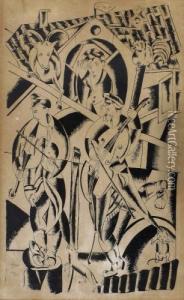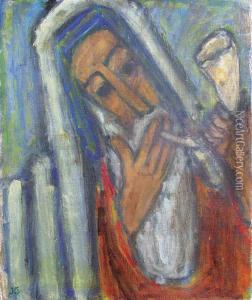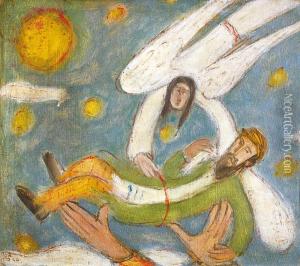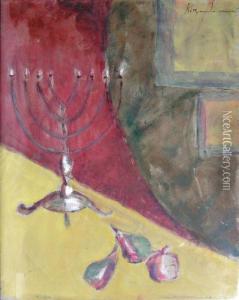Jesekiel Kirszenbaum Paintings
Jesekiel David Kirszenbaum, born in Staszów, Poland, was a Jewish-Polish painter whose work reflects a tumultuous life marked by the upheaval of war, displacement, and the search for artistic expression amidst the darkest times of the 20th century.
Kirszenbaum grew up in a Hasidic family, and his early exposure to religious texts and traditional Jewish culture informed his later artistic creations. Despite his traditional upbringing, he was drawn to art, and his quest to become an artist led him to leave Poland for Germany. In Weimar Berlin of the 1920s, he studied at the Bauhaus, a hotbed of avant-garde art and design, where he was exposed to a variety of modern artistic movements and techniques. His work from this period shows influences of Expressionism and Cubism, and he was involved in the vibrant cultural life of Berlin, which at the time was a sanctuary for many Jewish artists and intellectuals.
However, Kirszenbaum's burgeoning career was abruptly interrupted by the rise of the Nazis. With the advent of National Socialism and its repressive and anti-Semitic policies, Kirszenbaum, like many other Jewish artists, faced persecution. In 1933, he fled to Paris, where he continued to work and became part of the city's community of emigrant artists. His work during this period became more reflective of his personal experiences as an exile, often depicting themes of loss, nostalgia, and the suffering of the Jewish people.
The outbreak of World War II and the subsequent occupation of France by Germany brought further tragedy to Kirszenbaum's life. Most of his family perished in the Holocaust, and he himself was forced to go into hiding. His studio was looted, and many of his artworks were destroyed or lost.
After the war, Kirszenbaum attempted to rebuild his life and career in France. He continued to paint, and his post-war work often conveyed a sense of mourning and the search for meaning after the devastation he had witnessed. Despite the hardships he faced, Kirszenbaum's art retained a vibrant use of color and a dynamic, if sometimes melancholic, celebration of life.
Jesekiel Kirszenbaum's legacy as an artist is marked by his resilience and his capacity to transform personal and collective tragedy into poignant works of art. His oeuvre is a testament to the human spirit's ability to create beauty and meaning in the face of adversity. Kirszenbaum died in Paris in 1954, leaving behind a body of work that continues to be appreciated for its emotional depth and artistic merit.



